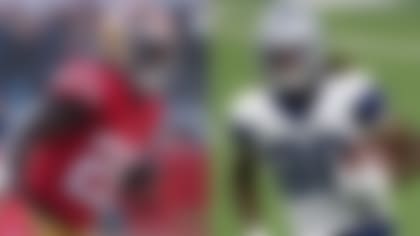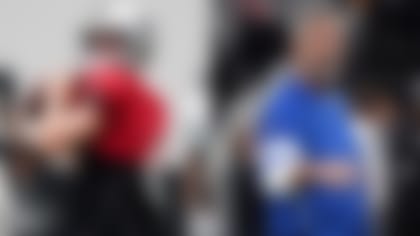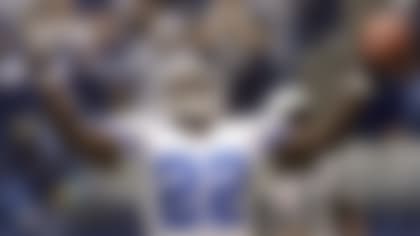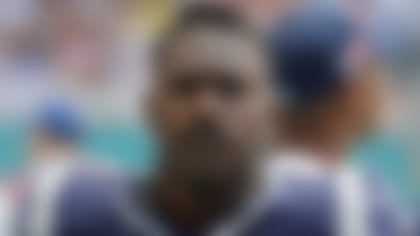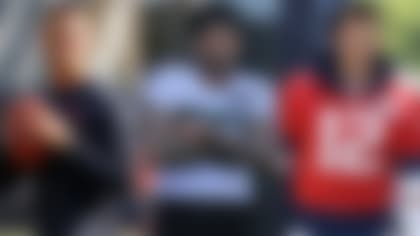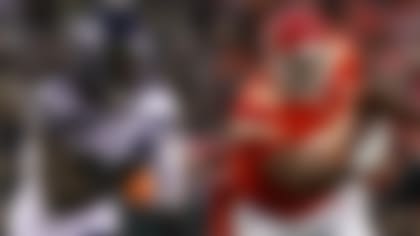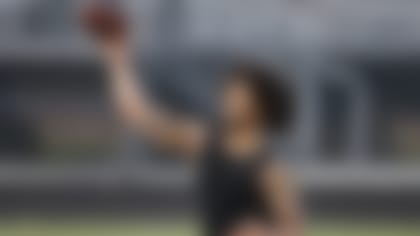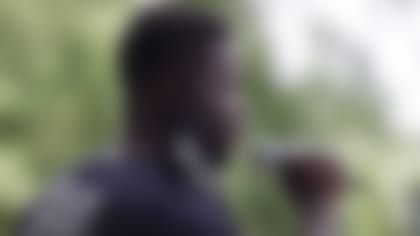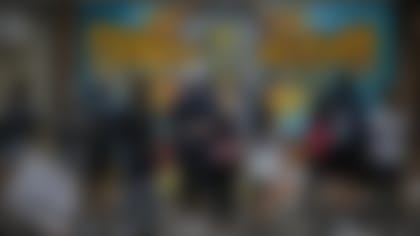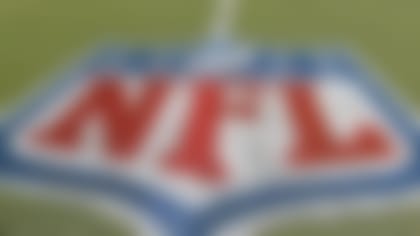In NFL.com's Press Coverage series, columnists Judy Battista, Jeffri Chadiha, Michael Silver and Jim Trotter engage in a back-and-forth discussion on a timely topic, issue or theme. In this edition, with the 2020 NFL Draft fast approaching, these four well-traveled scribes take a look back at some of the most unforgettable moments from their decades of draft coverage.
JIM TROTTER: Remember Eli's awkward/fruitful power play on the Bolts?
At the NFL Scouting Combine two months ago, LSU quarterback Joe Burrow walked into a large room at the Indiana Convention Center and took a seat on a raised dais. He wore a black long-sleeve T-shirt, black sweatpants and a disarming smile. He knew what was coming and was prepared for it.
You don't throw for 60 touchdowns in a season, as Burrow did last year while leading the Tigers to the national title, without being able to identify and exploit press coverage. So when reporters blitzed him with at least a dozen variations of the same question -- Will you play for the Bengals if they select you No. 1 overall? -- the Heisman Trophy winner with the cropped blonde hair and cool demeanor handled the situation with the poise and polish he had demonstrated in the pocket throughout the 2019 season.
"Yeah," he said, with a slight chuckle.
He repeated variations of the same answer each time he was asked, affirming what I believed all along: that this was manufactured drama. But as I listened to him speak, it also brought back memories of a real staredown between a quarterback and a team with the No. 1 pick: Eli Manning vs. the San Diego Chargers back in 2004.
Every draft has an element of drama, but this one was fascinating because it came out of nowhere and pitted one of the game's most powerful agents against an unproven and seemingly overmatched general manager. I was a Chargers beat writer for The San Diego Union-Tribune at the time, and it wasn't until the week of the draft that we got any hint of trouble between the sides. Just days before the Bolts were set to officially go on the clock, second-year GM A.J. Smith announced that Manning's agent, Tom Condon, had informed the club of Manning's desire to play for the Giants and would sit out the season and re-enter the draft if San Diego selected him.
The Chargers, who held the first pick for the second time in four years and had gone eight consecutive seasons without a winning record, were known to be in the market for a quarterback after benching second-year starter Drew Brees for the five games of the previous year. The expectation was that they would select the latest member of the First Family of NFL Quarterbacks.
Manning's father, Archie, was drafted No. 2 overall by the Saints in 1971, and his brother, Peyton, was taken first overall by the Colts in 1998. However, unlike those two, Eli attempted to flex on the Chargers, who viewed it as the ultimate slap in the face. It was an affront to the fan base and an insult to the organization as a whole.
Smith, who was coming off a poor draft and a 4-12 rookie season, was adamant about not being pushed around by Condon. He may have appeared laid back with the pastel Tommy Bahama shirts and sock-less loafers, but an intense competitive fire burned inside him. He had watched Condon play hardball with the Chargers three years earlier by holding rookie running back LaDainian Tomlinson out of training camp for 32 practices in a contract dispute, and he would be damned if Condon was going to hold them hostage again. That impasse in 2001 angered Smith and the Bolts for several reasons: Smith, then a chief lieutenant to GM John Butler, was part of a new front office that had come in from Buffalo; the team was coming off a 1-15 season and wanted to show Butler & Co. had the chops to turn things around; and the local fan base was skeptical after management traded away the first pick in that draft and a chance to select Michael Vick, who at that time was the most electrifying prospect in that draft.
Without tipping his hand to head coach Marty Schottenheimer, who also was represented by Condon, Smith devised a plan in which he would draft Manning and then trade him to the Giants, who had the fourth pick overall. But not before making the Ole Miss star and his family squirm uncomfortably before an international TV audience.
Smith knew that Giants GM Ernie Accorsi was desperate to acquire Manning after missing out on John Elway in 1983. That year, Elway pulled a similar power play by telling the Baltimore Colts (for whom Accorsi worked at the time) that he would not sign with them if they drafted him first overall. Baltimore drafted him anyway and then traded him to the Broncos.
Smith followed that same blueprint and took great pleasure in seeing Manning and his parents awkwardly pose on stage with commissioner Paul Tagliabue while holding up a Chargers jersey. It was an indelible moment that made that draft so memorable, just as the debate of whether to take Ryan Leaf or Peyton Manning made the 1998 draft unforgettable, or the Texans' decision to take Mario Williams over Reggie Bush made for great intrigue in 2006, or the discussion about what Cam Newton's smile purportedly revealed about his character made 2011 so notable.
JEFFRI CHADIHA: Yes, I tracked Eli through New York City like a CIA agent
That 2004 draft was the craziest one I've ever been around in my time covering the NFL. I was working for Sports Illustrated -- back with a younger, more dashing Mike Silver -- and I had to follow Eli around as part of our coverage. Usually, this would've been a simple assignment, but it got really wild once news broke that the quarterback wanted nothing to do with the Chargers.
This was back in the days when the league only invited a handful of prospects to New York for the draft and then held a bunch of media events for them. There were probably six or seven players in town at the time -- including Ben Roethlisberger and Kellen Winslow II -- but Eli was the main attraction. Nobody could get close to him and Archie was definitely a key part of the protection scheme.
The crappy part for me was that I had to find a way to write a story without any real access. SI was still the dominant force in sports journalism in those days, so normally a player tabbed to be the top pick in the draft would be an easy interview to snare. Instead, I felt like some CIA agent trying to keep tabs on a potential asset as he moved throughout the city. I actually remember begging a friend who was a producer on the CBS Morning Show to let me hang backstage while the players conducted interviews there. I also recall a luncheon at Tavern on the Green where it was impossible to find any time with Eli that didn't involve other media.
Keep in mind, the first three rounds of the draft came on Saturday back then, so I spent two days just shadowing Eli. I did get a few minutes with Archie at his hotel's bar on the Friday before the event, just to lay out what I needed for the story. I knew two things after that brief conversation. One was that there was no way Eli Manning was ever going to play for the Chargers. The other, as Jim mentioned above, was that the Chargers weren't going to tip their hand until shortly after noon eastern time on that Saturday.
That mystery -- and the potential for high-stakes drama -- is what made that draft the most interesting. By that point, we'd seen so many drafts where a team already had determined the top pick weeks, if not months, in advance. The only real question surrounding No. 1 selections like Carson Palmer or Michael Vick was how much money they would demand (this was long before the rookie wage scale would be instituted for draftees). If the Chargers really did take Eli, it was hard to know just what his options would've been. Unlike Elway, whom the Yankees had selected in the second round of the 1981 MLB Draft, Eli couldn't just use a baseball career as leverage.
It's been 16 years since that draft and I still remember the tension in Madison Square Garden before the Chargers' selection. It was even more awkward when they took Manning at No. 1 overall. There literally was an audible gasp in that room when Paul Tagliabue announced the pick. To top it all off, Eli had to pose for a photo while holding a Chargers jersey, with his parents and Tagliabue flanking him. It looked like somebody had asked him to clutch a hand grenade.
Of course, we all know what happened about a half-hour after that. The Giants took Philip Rivers, then announced a trade with the Chargers to swap quarterbacks (while also sending a 2004 third-round pick, as well as first- and fifth-round picks the following year to San Diego). What people often forget is that players didn't hang around the draft very long after being selected. As soon as those teams struck that deal, I had to hustle to catch Eli and his agent, Tom Condon, before they headed off to meet with the Giants.
I did catch up with Archie at the same hotel bar later in the evening. We ran into Roethlisberger in the lobby and Archie congratulated Big Ben on becoming the Pittsburgh Steelers' first-round pick. As it turns out, Roethlisberger would've been the Giants' Plan B if the Chargers had kept Eli's rights (former Giants general manager Ernie Accorsi revealed that fact years later). Archie also stressed that he never told his youngest son to pursue such a controversial path. Archie only supported the decision Eli and Condon had made about avoiding a Chargers franchise that had been a train wreck in those days.
I wound up with a story that pleased my editors. The teams and the quarterbacks involved -- including Roethlisberger -- all found themselves in places where they enjoyed great careers. However, I'll always remember that draft for a quote Archie gave me, which happened to be a bit of commentary Kellen Winslow Sr., a ChargersHall of Fame tight end, had offered after all the drama subsided.
"If that had been my son, I wouldn't have thought twice about it," Winslow told Archie. "I would've done the same damn thing."
MICHAEL SILVER: Experiencing Rodgers' slide from a top pick's draft party
It's true that I was younger and more dashing back in 2004 -- but the 2005 draft aged me a little. That was the year I was supposed to watch the quarterback who'd brought me so much pleasure as a Cal alum, Aaron Rodgers, ascend to his rightful plateau: at the top of the draft, as the feel-good pick for the team across the San Francisco Bay. Rodgers, a Northern California native, had grown up rooting for the 49ers, and when I saw him light it up at Cal's pro day in mid-March -- and leave straight from California Memorial Stadium to go to lunch with the Niners' top decision-makers -- it seemed like a wrap.
Then our paths diverged. Rodgers went to New York City and I, on assignment for Sports Illustrated, traveled to Gadsden, Alabama, to hang out with Carnell "Cadillac" Williams -- one of two Auburn running backs slated to come off the board early. The other, Ronnie Brown, was in New York with Rodgers, and woke up on the morning of the draft at the Westin Times Square. Williams had crashed at a Comfort Suites, where he was preparing to throw a party for family members, friends and seemingly everyone he'd ever met.
We met in the lobby, and Cadillac drove me in a black Escalade (naturally) to a nearby Waffle House. Thousands of calories and some very cool anecdotes later, we went back to the Comfort Suites to see where he'd begin his NFL career.
The suspense didn't last long: Williams took a call from then-Buccaneers coach Jon Gruden, whose franchise held the fifth pick in the draft, and began singing a church hymn in celebration. Brown was already off the board, having been selected No. 2 overall by the Dolphins. Within half an hour of Cadillac's big moment, I'd already interviewed him and enough of his friends and family members to feel pretty good about writing my story. Then I looked at the TV and saw Rodgers, looking miserable and uncomfortable, fidgeting in the green room -- a recurring image, as fate would have it -- and understood I needed to focus on what would turn out to be the real story of this draft.
That San Francisco had passed on Rodgers, instead selecting Utah's Alex Smith, definitely surprised me: Smith had operated exclusively out of the shotgun in then-Utes coach Urban Meyer's scheme, and if the Niners needed a quarterback who might have to come in and play right away (as Smith would, making his first start in Week 5 of his rookie campaign), there was no question that Rodgers was far more pro-ready. What shocked me, though, was the brazen, almost taunting manner in which 49ers coach Mike Nolan (who had personnel control at the time) began his press conference, polling the assembled reporters as to how many had believed the team would select Rodgers over Smith, and noting how many had been fooled.
Suffice it to say history would not give Nolan the last laugh.
As the first round dragged on, and the repeated shots of Rodgers became increasingly cringe-worthy, the situation became downright surreal. Sure, many of the teams picking in those slots had settled quarterback situations, but Rodgers seemed more toxic than a Superfund site (there's your 2005 reference). He'd already been screwed out of a Rose Bowl -- Cal hadn't been there since 1959, and don't get me started on the absurdity that led to the 2004 Bears being denied their rightful trip to Pasadena -- and now he was having a nightmarish draft experience, in front of everyone.
At one point, I felt a hand on my shoulder. "Rodgers still hasn't gone?" Williams asked incredulously. He had left the main area of his party and found me sitting at a table in a side room watching the draft on a small TV, and he stayed to watch the rest of the horror show. A few minutes later, blessedly, we saw Rodgers finally crack a reluctant smile. The Packers -- a team which happened to have a legendary quarterback -- took him 24th overall, ending a four-and-a-half-hour ordeal.
After shaking hands with Rodgers, NFL commissioner Paul Tagliabue leaned in close and told him, "Good things happen to people that are patient." This would be a recurring theme.
Three years later, Rodgers finally became the Packers' starter, following a wild offseason during which Favre retired, unretired and forced his way out of town. And now, 15 years after that very awkward draft experience, Rodgers is a future first-ballot Hall of Famer -- and he and I are still waiting for Cal's first Rose Bowl appearance in our lifetime.
JUDY BATTISTA: My painful (and illuminating) Johnny Football experience
I'm not sure what it says about Mike and me that our most memorable draft experiences involve watching people fall, but here we are.
Let me offer one disclaimer: My very first draft as the Jets beat writer for the New York Times was the 2000 event, when Gang Green had four first-round picks as the result of the "trade" of Bill Belichick to the Patriots and the nearly-as-shocking trade of Keyshawn Johnson to the Buccaneers. Bill Parcells, the Jets' football potentate, hit on all of those picks, but true to Parcells lore, he would not come downstairs to talk to reporters.
Watching coach Al Groh explain those picks couldn't compare to the most compelling draft spectacle I've ever covered, though. In 2014, for NFL Media, I was assigned to write a column on the scene from the draft in New York. Cool footnote: My writing spot that night was in the Rockettes' narrow dressing room.
The draft was still at Radio City Music Hall then, and as soon as I got to the green room and saw the layout, I knew exactly where I would be all night. Whoever had done the seating chart had placed the most riveting figure of the draft right next to the spot where the curtains parted for the entrance to the stage. That's where Johnny Manziel would sit.
On television, the green room always looks more luxurious than it is. At Radio City, it was cramped and claustrophobic and had the feel of an overstuffed church social crossed with the cantina scene from Star Wars. There were a lot of round tables and very large people in very nice suits and random people wandering through. Alabama coach Nick Saban paced nervously as his former players waited for their names to be called. Political consultant Frank Luntz was somewhere in there, too.
Jadeveon Clowney went first that year, and Manziel jumped up to embrace the looming, weeping pass rusher. That draft was replete with future stars, Clowney, Khalil Mack, Aaron Donald and Odell Beckham Jr. among them. But Manziel was the biggest college football star and the cameras swung to him after every pick, as if he had been the selection over and over.
What we saw: Johnny playing with a bottle cap. Johnny checking his phone. Johnny taking endless sips of water. When the Jacksonville Jaguars shocked everyone and took Blake Bortles third overall, Manziel sipped away and someone nearby muttered "That's not moving the meter."
When Manziel stood and started picking his way through the maelstrom, there was a bustle of activity, until someone in his camp told us he was just going to the bathroom. The wait continued when he returned, and hour after hour went by with his agent's phone silent. It was excruciating watching Manziel that night -- not because I had any special affinity for him, but because it is a strange kind of voyeurism to watch someone as their dreams begin to come apart. I feel bad for everybody in that spot.
As each player was chosen and had to walk right past him, Manziel had to make the instant calculation of whether he should congratulate the draftee (he did most enthusiastically for his former Texas A&M teammates, Jake Matthews and Mike Evans, who went back-to-back), look away or figure out something else to do. He had morphed, essentially, into the most scrutinized maitre d' on Earth.
The Cowboys were on the clock with the 16th pick and everyone wondered if Jerry Jones would flex his muscle and take Manziel. It was no secret that the Dallas owner was enamored of him, and Manziel was wearing a Cowboys-blue suit, matching his mom's lace dress. There was finally a buzz around Manziel's table, with all eyes on his agent's phone. Someone across the way at Greg Robinson's table said the pick would be Manziel.
But then it was guard Zack Martin. Depending on the version of events from Dallas, Stephen Jones had either snatched the Manziel card out of Jerry's hands or had at least prevailed upon him to take the dominant offensive lineman.
Manziel stared into space. And an NFL official, standing next to me, leaned over and whispered, "It's kind of morbid, isn't it?"
Well, yes. And it was consuming the room. The narrow space next to Manziel's table was gummed up with gawkers. Nobody was noticing that somewhere else in the room, Teddy Bridgewater -- who began the draft process as the best-regarded quarterback -- was also sliding.
Suddenly there was a trade and the Cleveland Browns were back on the clock with the 22nd pick. When the Browns picked eighth overall -- hours before -- the cameras had zoomed in on Manziel. Cornerback Justin Gilbert was the pick that time. (Oy.) The cameras focused on Manziel again, as he hunched over and finally held the phone to his ear. Out in the crowd, as the fans started to realize what was happening, the Browns fans -- including one wearing a T-shirt that read "Johnny Superbowl" -- started to celebrate. It was probably telling that, at that moment, Manziel looked much more relieved than excited. That changed quickly, when he finally got to walk through the parted curtain. He held his arms up, smiled and, as he approached Roger Goodell, made his infamous money sign -- the bluster and bravado returning that quickly.
There had been a thought whispered in the green room that maybe the slide would be good for college football's biggest party boy, that maybe that long wait would drag Manziel back down to Earth for his professional career.
Manziel said a lot of the right things that night -- that it was an honor to be a first-round pick, that he would go to work with a smile on his face to compete for a starting job. But that money sign is what has stuck with me from that night. It was the first signal that the "Johnny Football" personality hadn't been stripped away by that slide.

